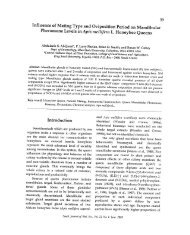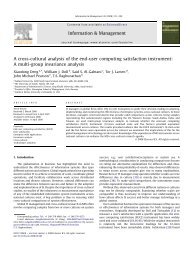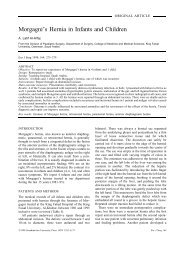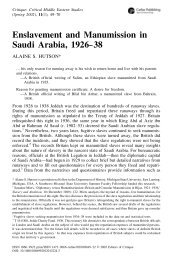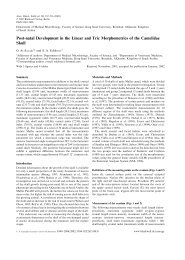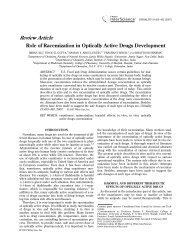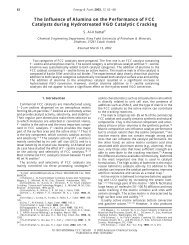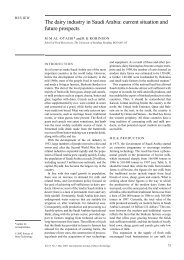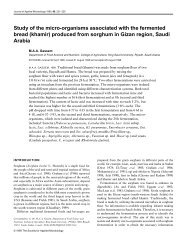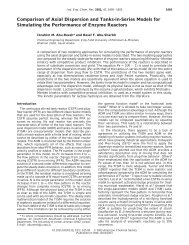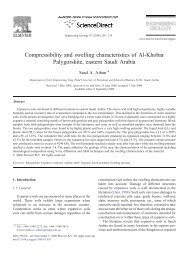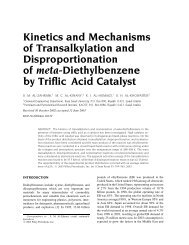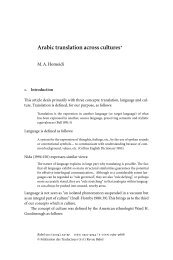followed by flame atomic absorption spectroscopy determination
followed by flame atomic absorption spectroscopy determination
followed by flame atomic absorption spectroscopy determination
You also want an ePaper? Increase the reach of your titles
YUMPU automatically turns print PDFs into web optimized ePapers that Google loves.
Arabian Journal of Chemistry (2010) 3, 21–26<br />
ORIGINAL ARTICLE<br />
Hollow fiber supported liquid membrane microextraction<br />
of Cu 2+ <strong>followed</strong> <strong>by</strong> <strong>flame</strong> <strong>atomic</strong> <strong>absorption</strong><br />
<strong>spectroscopy</strong> <strong>determination</strong><br />
Zarrin Es’haghi *, Rashin Azmoodeh<br />
Department of Chemistry, Faculty of Sciences, Payame Noor University, P.O. Box 26, Mashhad, Iran<br />
Received 2 February 2009; accepted 8 August 2009<br />
Available online 23 December 2009<br />
KEYWORDS<br />
Copper ion;<br />
Hollow fiber supported<br />
liquid membrane microextraction;<br />
Flame <strong>atomic</strong> <strong>absorption</strong><br />
spectrometry;<br />
8-Hydroxy quinoline<br />
1. Introduction<br />
The <strong>determination</strong> of trace heavy metal contents of environmental<br />
materials including natural water and food samples<br />
* Corresponding author.<br />
E-mail address: zarrin_eshaghi@yahoo.com (Z. Es’haghi).<br />
1878-5352 ª 2009 King Saud University. All rights reserved. Peerreview<br />
under responsibility of King Saud University.<br />
doi:10.1016/j.arabjc.2009.12.004<br />
Production and hosting <strong>by</strong> Elsevier<br />
King Saud University<br />
Arabian Journal of Chemistry<br />
www.ksu.edu.sa<br />
www.sciencedirect.com<br />
Abstract Hollow fiber supported liquid membrane microextraction, a relatively new sample preparation<br />
technique, has attracted much interest in the field of environmental analysis. In the current<br />
study, a novel method based on hollow-fiber liquid-phase microextraction and <strong>flame</strong> <strong>atomic</strong> <strong>absorption</strong><br />
spectrometry (FAAS) for the measurement of copper ion in aqueous samples is described. Hollow-fiber<br />
liquid-phase microextraction conditions such as the type of extraction solvent, pH, the<br />
stirring rate, and the amounts of chelating agents, sample volume, and the extraction time were<br />
investigated. Under the optimized conditions, the linear range was found to be 0.01–15 lgml 1<br />
for copper ion, and the limit of detection to be 0.004 lgml 1 . Tap water and surface water samples<br />
collected from Mashhad, Iran and Dorongar river; Khorasan, Iran, respectively, were successfully<br />
analyzed using the proposed method. The recoveries from the spiked water samples were 72.4% and<br />
105%, respectively; and the relative standard deviation (RSD) at the 2 lgml 1 level was 6%.<br />
ª 2009 King Saud University. All rights reserved.<br />
have been continuously performed to put forward the level<br />
of pollution levels of the environment <strong>by</strong> trace metals (Sabaliunas<br />
et al., 2003; Lindstro¨m et al., 2002; Blanca, 2008;<br />
Faruque and Hiroaki, 2006). For the direct <strong>determination</strong><br />
of heavy metals in environmental samples, a number of sensitive<br />
instrumental methods including <strong>atomic</strong> spectroscopic<br />
methods are available, which, however, can suffer from<br />
interferences <strong>by</strong> the matrix of the samples. Also, another<br />
important problem is the lower concentration of the analytes<br />
than the limit of detection of the instruments. Due to these<br />
points of view, a separation and preconcentration step for<br />
heavy metals is often necessary before the <strong>determination</strong> of<br />
the analytes (Suarez et al., 2009; Tuzen and Soylak, 2009;<br />
Ghaedi et al., 2009).<br />
Sample preparation is a bottle neck in the environmental<br />
analysis. Conventional solid-phase extraction (SPE) and
22 Z. Es’haghi, R. Azmoodeh<br />
liquid–liquid extraction (LLE) have been widely used for the<br />
extraction of metal ions from water samples (Chen et al.,<br />
2009b; Dadfarnia et al., 2009). It is well known, however,<br />
that these methods are time consuming, tedious, often require<br />
large amounts of organic solvent, and can be relatively<br />
expensive. Simplification and miniaturization of sample preparation<br />
is a recent trend in analytical chemistry (Arthur and<br />
Pawliszyn, 1990; Barri and Jo¨nsson, 2008). Solid-phase microextraction<br />
(SPME) and liquid-phase microextraction<br />
(LPME) are of most recently developed sample preparation<br />
techniques. Both techniques are typical representative of this<br />
novel trend. They eliminate the disadvantages of conventional<br />
extraction methods, such as being time consuming<br />
operation, the need for large amounts of organic solvent,<br />
and so on.<br />
Recently, liquid-phase microextraction or solvent microextraction<br />
was developed as a fast, simple and inexpensive<br />
solvent-minimized liquid–liquid extraction (LLE)<br />
technique Ma and Cantwell, 1999; Charalabaki et al.,<br />
2005. Subsequently, hollow-fiber liquid-phase microextraction<br />
(based on the application of a supported liquid<br />
membrane) was introduced using a porous hollow-fiber<br />
membrane (Dadfarnia and Haji-Shabani, 2010; Rasmussen<br />
and Pedersen-Bjergaard, 2004; Basheer and Lee, 2004) in<br />
order to improve solvent stability. In liquid-phase microextraction<br />
using a hollow-fiber membrane, the organic solvent<br />
is injected into and contained within the lumen of the<br />
porous hollow fiber as an interface between the sample<br />
solution and the extracting phase (the phase into which<br />
the analyte is extracted). Since very little solvent is used,<br />
exposure of the operator to toxic organic solvents is minimized.<br />
At the same time, the technique combines extraction,<br />
concentration and sample introduction into one step. It has<br />
been successfully used for the <strong>determination</strong> of chemical<br />
warfare agents (Millerioux et al., 2009), dichlorophenol<br />
isomers (Ziagova et al., 2009), primary amines (Desouky<br />
et al., 2009), polycyclic aromatic hydrocarbons (De La Torre-Roche<br />
et al., 2009), insecticides (Chen et al., 2009a),<br />
endocrine-disrupting alkylphenols, chlorophenols and<br />
bisphenol-A (Soares et al., 2008).<br />
The aim of this present study is to develop a simple, sensitive<br />
and cheap analytical method for the fast measurement<br />
of copper ion in environmental water samples. To date, and<br />
to the best of our knowledge, no report has been published<br />
on the measurement of copper ion in water samples using<br />
hollow-fiber liquid-phase microextraction <strong>by</strong> FAAS. 8-Hydroxy<br />
quinoline forms soluble derivatives with several inorganic<br />
species. By proper control of the pH of the solution<br />
or the concentration of 8-hydroxy quinoline or <strong>by</strong> using<br />
masking agents, a greater degree of selectivity may be<br />
achieved. Consequently, 8-hydroxy quinoline and its derivatives<br />
have been widely used as chelating and/or preconcentration<br />
agents in analytical chemistry. Martı´nez et al.<br />
(2008) reviewed the role of 8-hydroxy quinoline and its<br />
derivatives as reagents in analytical chemistry with the main<br />
emphasis on liquid extraction.<br />
In this study, copper ion in aqueous samples was first complexed<br />
with 8-hydroxy quinoline and then extracted with hollow-fiber<br />
liquid-phase microextraction, and finally determined<br />
<strong>by</strong> <strong>atomic</strong> <strong>absorption</strong> spectrometry. The method developed<br />
was applied to real environmental samples with satisfactory<br />
results.<br />
2. Experimental<br />
2.1. Reagents and materials<br />
Acetone, 1-octanol and methanol (HPLC grade), HCl,<br />
NaOH all were obtained from Merck (Darmstadth, Germany).<br />
8-Hydroxy quinoline was purchased from Fluka (Buchs, Switzerland).<br />
8-Hydroxy quinoline solution was prepared in 1-octanol.<br />
Working solutions of copper were prepared daily <strong>by</strong><br />
proper dilution of the stock solution with double-distilled<br />
water. All solutions were stored at 4 °C in dark. The metal salts<br />
and other chemicals used were of analytical reagent grade. The<br />
stock solutions of metal ions (concentration 100 mg l 1 ) were<br />
prepared from analytical reagent grade. The water samples<br />
from Dorongar River collected, filtered and stored in corning<br />
glass bottles. All other chemicals were of analytical grade.<br />
The Accurel Q 3/2 polypropylene hollow-fiber membrane<br />
was purchased from Membrana (Wuppertal, Germany). The<br />
inner diameter was 600 lm, the thickness of the wall was<br />
200 lm, and pore size was 0.2 lm. Before use, the hollow-fiber<br />
membrane was sonicated in acetone for several minutes to remove<br />
any possible contaminants. The fiber was then removed<br />
from the acetone and allowed to dry completely.<br />
2.2. Instrumentation<br />
The measurements of metal ions were performed with a Model<br />
PU9600X Philips <strong>flame</strong> <strong>atomic</strong> <strong>absorption</strong> spectrometer<br />
equipped with a single element hollow-cathode lamp and<br />
5.0 cm of an air/acetylene burner head. The instrumental<br />
parameters were those recommended <strong>by</strong> the manufacturer.<br />
The selected wavelength (nm) for analyte is 324.8 nm. A digital<br />
pH meter (Metrohm Instruments Model 744) with a glass electrode<br />
was used for all pH measurements.<br />
2.3. Sample preparation<br />
A 10 ml vial with a stir bar was placed on a magnetic stirrer.<br />
Seven millilitres of working solution aqueous samples were<br />
placed in the vial. Then, 0.1 M sodium hydroxide solution<br />
was added for pH adjustment. HF-LPME experiments were<br />
performed as previously described (Barri and Jo¨nsson, 2008;<br />
Rasmussen and Pedersen-Bjergaard, 2004; Basheer and Lee,<br />
2004). Briefly, HF-LPME was performed with a commercially<br />
available 50 ll Hamilton microsyringe. Before each extraction,<br />
the syringe was rinsed with at least 10 times with the solvent.<br />
The hollow fiber was immersed into the solvent for<br />
impregnation of its wall. Then the hollow fiber was removed<br />
from the solvent and its outside was washed with 1 ml of ethanol.<br />
A 20 ll aliquot of organic solvent was withdrawn into<br />
the microsyringe and was injected in the lumen of the fiber,<br />
so that the channel of the fiber was filled with the extracting<br />
solvent. It was immersed into the donor aqueous solution<br />
containing analytes. During the extraction, the solution was<br />
stirred at a reasonable stirring rate. When the extraction<br />
was finished (after 30 min), the extraction solvent was retracted<br />
into the syringe, which was removed from the sample<br />
vial. The hollow-fiber membrane was then discarded. The extracted<br />
analyte was introduced to the FAAS, and analysis was<br />
carried out.
Hollow fiber supported liquid membrane microextraction 23<br />
Absorbance<br />
0.2<br />
0.18<br />
0.16<br />
0.14<br />
0.12<br />
0.1<br />
0.08<br />
0.06<br />
0.04<br />
0.02<br />
0<br />
0 2 4 6 8 10<br />
pH<br />
Figure 1 Effect of pH on the extraction efficiency.<br />
3. Results and discussion<br />
3.1. Effect of pH on the extraction<br />
The pH study was carried out to investigate its effect on the<br />
extraction of copper ions with the proposed procedure at the<br />
range 2–9. The results are depicted in Fig. 1. According to<br />
the results the optimum pH was selected as 8.0 for the donor<br />
solution.<br />
3.2. The effect of sample volume on the extraction<br />
Because of low concentrations of copper ion in real samples,<br />
large sample volume is generally required for effective preconcentration<br />
and <strong>determination</strong> of trace metals. According to the<br />
last researches (Barri and Jo¨nsson, 2008; Ma and Cantwell,<br />
1999; Rasmussen and Pedersen-Bjergaard, 2004; Basheer and<br />
Lee, 2004) recovery % (R %) was calculated according to<br />
the following equation for each analyte:<br />
R ¼ na; final=ns; initial 100%<br />
¼ðVa=VsÞ ðCa; finalÞ=ðCs; initialÞ 100%; ð1Þ<br />
where ns, initial and na, final are the number of moles of analyte<br />
present in the initial sample and the number of moles of<br />
analyte finally collected in the acceptor solution, respectively.<br />
Va is the volume of acceptor solution, Vs the volume of sample,<br />
Ca, final, the final concentration of analyte in the acceptor<br />
solution, and Cs, initial, is the initial analyte concentration<br />
within the sample.<br />
The concentration enrichment (EF) was calculated <strong>by</strong> the<br />
following formula:<br />
EF ¼ðCa; finalÞ=ðCs; initialÞ ¼ðVs=VaÞ R=100: ð2Þ<br />
To achieve a good enrichment usually large sample volume has<br />
to be used. Therefore, to maximize the sample/acceptor volume<br />
ratio instead of increasing the sample volume, acceptor<br />
volume could be minimized. It can be easily done using a hollow<br />
fiber as a support for liquid membrane.<br />
On the other hand, the volume of donor phase depending<br />
on the size of the vial. Thus for achieving the best volume<br />
phase ratio condition, we fixed the acceptor phase volume<br />
(or the length of the fiber used was fixed on 8.0 cm) and the donor<br />
phase volume was changed till achieving the optimal phase<br />
volume ratio. Therefore, the effects of sample volume on the<br />
Absorbance<br />
0.2<br />
0.18<br />
0.16<br />
0.14<br />
0.12<br />
0.1<br />
0.08<br />
3 5 7 9 11<br />
Donner phase volume (ml)<br />
Figure 2 The effect of donor phase volume on the extraction<br />
efficiency.<br />
recoveries of the analytes were investigated <strong>by</strong> using model<br />
solutions containing the same amount of trace metals in the<br />
volume range of 4–9 ml. The results are given in Fig. 2.<br />
3.3. Extraction time<br />
Like SPME, static LPME is a process that is dependent on<br />
equilibrium rather than on exhaustive extraction (Arthur and<br />
Pawliszyn, 1990; Barri and Jo¨nsson, 2008; Ma and Cantwell,<br />
1999; Charalabaki et al., 2005). The principle behind LPME<br />
is the equilibrium partition of the analyte between the extraction<br />
solvent and aqueous solution. In LPME, as discussed for<br />
SPME <strong>by</strong> Pawliszyn (Barri and Jo¨nsson, 2008), once the partition<br />
equilibrium is reached, the amount of analyte extracted<br />
has a linear relationship with the initial concentration of the<br />
analyte in the sample matrix. The effect of extraction time<br />
was examined in the range of 20–60 min at room temperature<br />
with the sample stirred at constant speed using a 7 ml sample<br />
of working solution.<br />
The results, as shown in Fig. 3, demonstrate that the<br />
<strong>absorption</strong> signal generally increased with extraction time.<br />
After 40 min, with additional extraction time, the LPME system<br />
began to decrease. These results indicated that the organic<br />
solvent is being lost. However, it seems a time to take 30 min is<br />
appropriate.<br />
3.4. Selection of extraction solvent and stirring rates<br />
It is essential to select a proper organic solvent for the HF-<br />
LPME method, which is dependent on the chemical nature<br />
of the target analytes (Barri and Jo¨nsson, 2008). Three solvents<br />
including chloroform, 1-octanol and mixture of them were<br />
compared. Chloroform evaporated during the experiment<br />
and it was also lost during the extraction process. Therefore,<br />
in subsequent experiments 1-octanol, was chosen as the extraction<br />
solvent (Fig. 4).<br />
Stirring the water samples can enhance the diffusion of the<br />
analytes towards the hollow fiber containing the extraction solvent,<br />
reducing the extraction equilibrium time. In these experiments<br />
low, medium and high stirring rates were tested. The<br />
stirring rate was optimized. The experimental results obtained<br />
are shown in Fig. 5. Although higher stirring rates resulted in<br />
greater extraction efficiencies, they also gave rise to bubbles on<br />
the surface of the hollow fiber, which affect the repeatability of
24 Z. Es’haghi, R. Azmoodeh<br />
Absorbance<br />
0.2<br />
0.18<br />
0.16<br />
0.14<br />
0.12<br />
0.1<br />
0.08<br />
10 20 30 40 50 60 70<br />
Time (min)<br />
Figure 3 The effect of extraction time on the process.<br />
Absorbance<br />
0.16<br />
0.14<br />
0.12<br />
0.1<br />
0.08<br />
0.06<br />
0.04<br />
0.02<br />
0<br />
the extraction. Therefore 900 rpm stirring rate was used in subsequent<br />
experiments.<br />
3.5. Ionic strength<br />
OC OC70%- OC50%-<br />
CL30% CL50%<br />
solvent<br />
Figure 4 The organic solvent effect on the extraction efficiency;<br />
OC, octanol and CL, chloroform.<br />
Absorbance<br />
0.22<br />
0.21<br />
0.2<br />
0.19<br />
0.18<br />
0.17<br />
0.16<br />
0.15<br />
0.14<br />
0.13<br />
0.12<br />
500 600 700 800 900 1000 1100<br />
Stirring rate (rpm)<br />
Figure 5 The effect of stirring rate on the extraction efficiency.<br />
The addition of salt improves the extraction efficiency in many<br />
conventional extraction techniques, and sodium chloride<br />
(NaCl) is commonly added to analytical samples (Rasmussen<br />
and Pedersen-Bjergaard, 2004). Therefore, the effect of salt<br />
concentration on extraction efficiency was tested <strong>by</strong> adding<br />
NaCl at 0.5–10% (w/v), respectively. The results obtained<br />
showed that the salt almost had positive effect on the extraction<br />
efficiency of the copper ion. The optimal concentration<br />
of NaCl was obtained at 1.0% w/v. Thus, the LPME was done<br />
CL<br />
Absorbance<br />
0.35<br />
0.3<br />
0.25<br />
0.2<br />
0.15<br />
0.1<br />
0 2 4 6 8 10 12<br />
Salt concentration (w/v% )<br />
Figure 6 The effect of NaCl concentration on the extraction of<br />
Cu 2+ .<br />
with the addition of NaCl with a concentration of 1.0% w/v<br />
(see Fig. 6).<br />
3.6. Surfactant effect<br />
Surfactants, or surface active agents, are amphiphilic molecules<br />
which are added to donor phase. The head of the surfactants<br />
are polar, or hydrophilic, and the tail of then are<br />
hydrophobic. The tail is generally a hydrocarbon chain with<br />
different number of carbon atoms and may be linear or<br />
branched, and also contains aromatic rings. One of the most<br />
important properties of these compounds is their good capacity<br />
to solubilize solutes of different character and nature.<br />
In this work, the effect of nonionic surfactants, Brij54, and<br />
Span 80 were tested. But these compounds have not shown the<br />
positive effect on the Cu 2+ extraction. Its may be due to the<br />
high viscosity of surfactants and thus these molecules closed<br />
the pores of polypropylene hollow fiber.<br />
Table 1 Effect of ionic interferences on the copper ion<br />
microextraction procedure.<br />
Interfering<br />
ions<br />
Mg 2+<br />
Mg 2+<br />
Mg 2+<br />
Ca 2+<br />
Ca 2+<br />
Ca 2+<br />
K +<br />
K +<br />
K +<br />
Interfering ions<br />
concentration (lgml 1 )<br />
A b (Au) A a (Au)<br />
20 0.297 0.289<br />
200 0.297 0.269<br />
2000 0.297 0.266<br />
20 0.297 0.278<br />
200 0.297 0.221<br />
2000 0.297 0.291<br />
20 0.297 0.250<br />
200 0.297 0.276<br />
2000 0.297 0.210<br />
SO 2<br />
4 20 0.297 0.298<br />
SO 2<br />
4 200 0.297 0.292<br />
SO 2<br />
4 2000 0.297 0.283<br />
CO 2<br />
3 20 0.297 0.214<br />
CO 2<br />
3 200 0.297 0.295<br />
CO 2<br />
3 2000 0.297 0.293<br />
C2O 2<br />
4 20 0.297 0.281<br />
C2O 2<br />
4 200 0.297 0.270<br />
C2O 2<br />
4 2000 0.297 0.180<br />
a Analyte <strong>absorption</strong> before addition of interfering ions.<br />
b Analyte <strong>absorption</strong> after addition of interfering ions.
Hollow fiber supported liquid membrane microextraction 25<br />
3.7. Interferences study<br />
The influence of increased concentration of some cations<br />
and anions on the interfering effects of Cu(II) is shown in<br />
Table 1. In the third concentration stage individual influence<br />
of each interfering ion on copper preconcentration at the optimal<br />
conditions was examined.<br />
Selectivity of the copper ion was investigated and possibility<br />
of different metal ions extraction was evaluated for three concentration<br />
levels of each interfering ion.<br />
There was no significant change in copper ion <strong>absorption</strong> in<br />
the presence of the ionic species. Result shows that metal ions<br />
at the concentrations much higher than those likely to be<br />
encountered in an environmental water sample did not interfere<br />
with the quantitative analysis of Cu(II). It should be noted<br />
that some metal cations in particular which has the same electronic<br />
configuration as Cu(II), showed no interference with the<br />
formation of the Cu and 8-hydroxy quinoline complex. These<br />
data confirm to the specificity of the microextraction method<br />
and reagent for copper <strong>determination</strong>.<br />
Absorbance<br />
1.6<br />
1.4<br />
1.2<br />
1<br />
0.8<br />
0.6<br />
0.4<br />
0.2<br />
0<br />
y = 0.0884x + 0.0705<br />
R 2 = 0.9952<br />
0 5 10 15 20<br />
Concentration (ppm)<br />
Figure 7 Calibration curve and equation parameters of the<br />
method under the optimal conditions.<br />
Table 2 Relative recovery % (RR %) and RSD % for<br />
environmental water samples.<br />
Water sample RR (%) RSD (%)<br />
Tap water 72.4 4.3<br />
River water 105.0 7.5<br />
4. Analytical performance and application to environmental<br />
water samples<br />
Under the above optimum conditions, some characteristics of<br />
the present method were investigated and the calibration curve<br />
was drawn (see Fig. 7).<br />
The linear range and the limit of detection were calculated.<br />
Linearity was observed over the range 10–15,000 lgl 1 for<br />
copper ion, with a correlation coefficient of r = 0.9952. The<br />
limit of detection (LOD), based on a signal-to-noise ratio (S/<br />
N) of 3, was 4.00 lgl 1 . The enrichment factor of the method<br />
was 551.00 (see Table 2). The proposed method was then applied<br />
to the <strong>determination</strong> of copper ion in water samples.<br />
Tap water was collected from Mashhad, Iran. The other samples<br />
were collected from the Drongar River. Analytical results<br />
show that they were free of copper ion contamination.<br />
In order to test the present method, the relative recoveries<br />
of copper ion were calculated and reported as 72.4% and<br />
105% for the tap water and Drongar river water samples,<br />
respectively. To assess the precision of the measurement, the<br />
repeatability of the method was determined <strong>by</strong> performing it<br />
four times using tap water samples spiked with 0.5 lgml 1<br />
copper ion. The relative standard deviation of the method<br />
(RSD %) was 5.7%.<br />
5. Conclusion<br />
Hollow fiber supported liquid membrane microextraction is<br />
fast, effective, inexpensive, virtually solvent free method which<br />
provides a high degree of selectivity and enrichment. The disposable<br />
nature of the hollow fiber totally eliminates the possibility<br />
of sample carry over and ensures high reproducibility. In<br />
addition, the small pore size prevents large molecules in matrix<br />
and un-solved particles in the donor solution from entering the<br />
acceptor phase, thus yielding very clean extract. All this, combined<br />
with the fact that HF-LPME should be relatively easy to<br />
automate, suggest that hollow fiber-based LPME may become<br />
an important technique for preconcentration and extraction of<br />
metal ions.<br />
This technique is compatible with a broad range of<br />
analytes, including biological and environmental samples and<br />
in connection with wide range of analytical instruments,<br />
such as spectroscopic and chromatographic methods like<br />
AAE, HPLC, GC and CE. This compatibility may provide a<br />
strong platform for future analytical extractions. The<br />
review of some methods which were used for <strong>determination</strong><br />
of Cu 2+ in the environmental water samples is shown in<br />
Table 3.<br />
Table 3 Comparison of HF-LPME with some other extraction methods for <strong>determination</strong> of Cu 2+ in the environmental water<br />
samples.<br />
Method EF LOD (lgl 1 ) Linear range (lg l 1 ) RSD (%)<br />
HLLE-FAAS Farajzadeh et al., 2009 – 6.0 10–2000 7.6<br />
DLLME-AAS Farajzadeh et al., 2008 – 3.0 50–2000 5.1<br />
MSE-ICP-OES Suleiman et al., 2009 96 – – 4.6<br />
SPE-FAAS Kiran et al., 2007 – 75 – –<br />
HF-LPME-FAAS (this work) 551.00 4.0 10–5000 5.7<br />
HLLE: homogeneous liquid–liquid extraction, DLLME: dispersive liquid–liquid microextraction, MSE: internal standard liquid–liquid microextraction,<br />
SPE: solid-phase extraction.
26 Z. Es’haghi, R. Azmoodeh<br />
Acknowledgments<br />
The authors wish to thank the Payame Noor University,<br />
Mashhad, Iran for financial support of this work.<br />
References<br />
Arthur, C.L., Pawliszyn, J., 1990. Anal. Chem. 62, 2145.<br />
Barri, T., Jo¨nsson, J.A., 2008. J. Chromatogr. A 1186, 16.<br />
Basheer, C., Lee, H.K., 2004. J. Chromatogr. A 1057, 163.<br />
Blanca, A.L., 2008. Environ. Int. 34, 292.<br />
Charalabaki, M., Psillakis, E., Mantzavinos, D., Kalogerakis, N.,<br />
2005. Chemosphere 60, 690.<br />
Chen, S., Yu, X., He, X., Xie, D., Fan, Y., Peng, J., 2009a. Food<br />
Chem. 113, 1297.<br />
Chen, D., Hu, B., Huang, C., 2009b. Talanta 78, 491.<br />
Dadfarnia, S., Haji-Shabani, A.M., 2010. Anal. Chim. Acta. 658, 107.<br />
Dadfarnia, S., Haji-Shabani, A.M., Kamranzadeh, E., 2009. Talanta<br />
79, 1061.<br />
De La Torre-Roche, R.J., Lee, W.Y., Campos-Díaz, S.I., 2009. J.<br />
Hazard. Mater. 163, 946.<br />
Desouky, O.A., Daher, A.M., Abdel-Monem, Y.K., Galhoum, A.A.,<br />
2009. Hydrometallurgy 96, 313.<br />
Farajzadeh, M.A., Bahram, M., Ghorbani Mehr, B., Jo¨nsson, J.A.,<br />
2008. Talanta 75, 832.<br />
Farajzadeh, M.A., Bahram, M., Zorita, S., Ghorbani Mehr, B., 2009.<br />
J. Hazard. Mater. 30, 1535.<br />
Faruque, A., Hiroaki, I., 2006. Atmos. Environ. 40, 3835.<br />
Ghaedi, M., Shokrollahi, A., Kianfar, A.H., Pourfarokhi, A., Khanjari,<br />
N., Mirsadeghi, A.S., Soylak, M., 2009. J. Hazard. Mater.,<br />
1408.<br />
Kiran, K., Suresh Kumar, K., Suvardhan, K., Janardhanam, K.,<br />
Chiranjeevi, P., 2007. J. Hazard. Mater. 147, 15.<br />
Lindström, A., Buerge, I.J., Poiger, T., Bergqvist, P., Mu¨ller, M.,<br />
Buser, H.R., 2002. Environ. Sci. Technol. 36, 2322.<br />
Ma, M., Cantwell, F.F., 1999. Anal. Chem. 71, 388.<br />
Martínez, R., Zoli, L., Giorgio Cozzi, P., Ramo´n, D.J., Yus, M., 2008.<br />
Tetrahedron 19, 2600.<br />
Millerioux, J., Cruz, C., Bazire, A., Lallement, G., Lefeuvre, L., Josse,<br />
D., 2009. Toxicol. Vitro 23, 539.<br />
Rasmussen, K.E., Pedersen-Bjergaard, S., 2004. Trends Anal. Chem.<br />
23, 1.<br />
Sabaliunas, D., Webb, S.F., Hauk, A., Jacob, M., Eckhoff, W.S., 2003.<br />
Water Res. 37, 3145.<br />
Soares, A., Guieysse, B., Jefferson, B., Cartmell, E., Lester, J.N., 2008.<br />
Environ. Int. 34, 1033.<br />
Suarez, S., Lema, J.M., Omil, F., 2009. Bioresour. Technol. 100, 2138.<br />
Suleiman, J.S., Hu, B., Peng, H., Huang, C., 2009. Talanta 77, 1579.<br />
Tuzen, M., Soylak, M., 2009. J. Hazard. Mater. 162, 724.<br />
Ziagova, M., Kyriakou, G., Liakopoulou-Kyriakides, M., 2009. J.<br />
Hazard. Mater. 163, 383.



